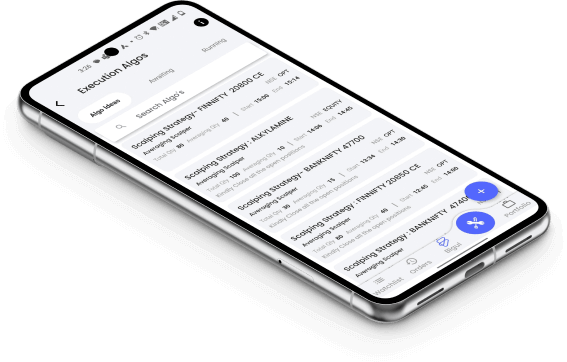Open an Account & Start Algo Trading Today!
- Flat Rs 18 brokerage
- No Cost Algo Trading
- Trade from Chart
- 30+ Indicators
- Stock SIP
- Smart Case
- Bigul Option Chain
- 300+ Pre Defined Market Watch
- IPOs
- Basket Order
Intraday Trading Tips for Today
Intraday trading has become a preferred choice among
many traders who want to make money from the stock market’s daily price
fluctuations. When you do intraday trading, you buy and sell the stocks on the
same day, so it is indeed an action-packed form of trading.
However, to do well in this type of trade, you need to
keep yourself updated with daily tips and updates of the market as these help
in making correct decisions and minimize risks as well.
In this article, let us look at some intraday trading
tips that will help you while doing intra-day trading today.
Intraday Trading Tips
Here are some of the best intraday trading tips to
consider for today:
1. Analyze Pre-Market Data
Analyzing
pre-market data is a staple of the intraday trading routine. It helps us
forecast what will likely happen shortly after the market opens.
Pre-market
activity unveils some important clues on stocks that are on the move, are
making news, or will be in play for the upcoming trading day. The increased
volatility and potential for inflated moves make this time of the day great for
opening trades with bigger profit targets.
Analyzing
pre-market data is a must because it creates the foundation for your game plan
for the next trading session.
Preparing and
planning your game plays before entering regular market hours allows you to
survive in fast markets and prevent overtrading during ole’ annoying, slow,
boring markets.
2. Focus on Liquidity and Volatility
It’s important
to focus on liquidity and volatility when day trading. Liquidity allows you to
enter and exit a stock at a good price (i.e., tight spreads, or the difference
between the bid and ask price of a stock, and low slippage, or the difference
between the expected price and actual executed price of a trade).
Volatility, on
the other hand, exposes traders to potential capital increases or declines in
stock throughout the day. High-volatility stocks mean more trading
opportunities because of their wider price swings to hit your profit target
within a short period of time.
If you can
focus on selecting stocks that have both liquidity and volatility
characteristics then you have high probabilities of making winning transactions
when trading in an ever-moving market.
3. Use Key Technical Indicators
To make right
decisions in intraday trading, it is very important to use some of the key
technical indicators.
Indicators
like Moving Averages, RSI and MACD shows you what is the trend in the market,
at what point of time a stock is overbought or oversold and when the trend of
stock or index may reverse. Moving Averages for example help you to smoothen
out price data so that you are able to see underlying trend and thereby act on
it and RSI tells their strength behind that trend.
MACD also
helps analyze momentum better by comparing various moving averages. Together,
these help traders understand when to initiate or liquidate positions and make
day trading more profitable.
4. Set Clear Entry and Exit Points
Setting a
clear entry and exit point is an important part of successful intraday trading.
This will help you manage your trades properly and also save you from emotional
moves.
Decide
beforehand some specific price levels, which will be treated as your exit or
entrance, for the trading day. This will ensure that you trade on some
predetermined strategies rather than taking speculative decisions based on
current prices.
This
methodology involves studying support and resistance levels in the market and
then making trades based on those levels.
By maintaining
these predetermined levels, we can stick to our trading plan, take losses as
small as possible and let winners run as much as that specific trade allows.
Over time, this helps us keep more discipline and take smaller losses and
bigger winners, creating further structure in trading.
5. Implement Strict Risk Management
Strict risk
management is necessary to safeguard capital in intraday trading.
Stop-loss
orders facilitate automatic exit from trade if prices move against the
position, thus limiting losses.
Keeping our
position sizes small helps to ensure that no single trade will ever seriously
hurt overall capital, especially during times when the market volatility is
high.
This way we
can effectively manage risks and avoid any serious financial damage. The key to
long term success with trading is being able to continue trading and stay in
the game, this means preserving your capital at all costs and a rigid
disciplined approach will allow you to do that.
6. Trade During Optimal Hours
Trading during
the right hours of the day can make a big difference to your intraday profits.
The opening hour and final hour of trading are typically the most volatile but
also the most likely to generate a profit.
Not only is
there more opportunity for price movement within these specific time slots, but
that initial hour often provides you with an opening range for the rest of the
day, also known as an anchor. And that final hour usually has a number of
traders taking positions overnight or squaring up positions before closure.
Allotting your
trading time into these windows brings with it increased market volatility and
hopefully paves the way for an overall successful trading experience.
7. Stay Updated with Market News
Market news
plays a critical role in day trading, as traders need to be able to respond
immediately to market events that can impact securities’ prices.
News stories
often report on important economic reports, corporate earnings announcements,
and government activity that cause pronounced price volatility or changes in
liquidity.
Monitoring
credible news sources helps traders stay updated with any development or news
that can impact their stocks which further enables them to take informed and
appropriate decisions at the right time.
Adapting to
changes & capitalizing on new opportunities in a dynamic market becomes
easy when you are updated with the latest.
8. Avoid Overtrading
It is
important to avoid overtrading which can easily come about as a result of
reacting to the emotional stresses and strains of intra-day trading rather than
from any planned or objective decision making. Overtrading can be costly in
terms of transaction costs and potential losses.
Having a
structured approach, a defined trading plan(s), and only executing trades based
on pre-defined criteria will prevent this from happening.
Keeping trades
in sync with predetermined strategies helps to ensure that all decisions are
based on logic and not emotion. This reduces the likelihood of making impulsive
short-term bets, which tend to eat into returns over time and impact overall
performance.
So remember,
if you want long-term success in intra-day trading, maintaining this discipline
is crucial.
9. Review Your Trades
At the end of
the day, reviewing your trades is extremely important to help improve your
intraday trading strategy. This involves going over each trade and trying to
determine what things worked and what did not.
Things such as
entry and exit points, why you made each trade, and how current market
conditions played a role in the results.
Identifying
patterns or errors allows you to optimize your strategy and make more informed
decisions during future trading sessions.
But it also helps you spot what’s working and what isn’t, which helps you build a better strategy overall.
Conclusion
With the help of the intraday trading tips mentioned in this article, one should be able to traverse today’s market with conviction. It is important to assess a given market environment, determine the most profitable stocks, and use appropriate technical indicators and resources. Applying risk management properly and choosing the right time to open and close your trades can make you successful in this endeavor. Being in touch with news and events of the market and avoiding making silly mistakes will also add to your trade. Using these advantages, grab the day trading opportunities and maximize your chances of making money efficiently. If you want to start Intraday Trading you will require Demat account, visit Bigul.co and open your free Trading and Demat account and enjoy lots of free service like Algo trading and many more.
FAQs
1. What
Investments Should I Consider for Day Trading?
Focus on
stocks with active trading and higher volatility. Such stocks are more likely
to experience price moves that are appropriate for intraday trading.
2. When is the
Right Time for Intraday Trading Activities?
The first hour
after the market opens and the last hour before it closes are, however, the
most active and therefore prone to offering better trading chances.
3. What are the
Practical Measures Taken to Control Risks in Intraday Trading?
Make sure to
implement stop-loss orders to protect against large losses, and do not go over
a very small percentage of your trading account as the maximum risk for one
trade.
4. What is the
Importance of Using Indicators for Day Trading?
Indicators support trade management by analyzing price movement. Most of such indicators are trend followers such as Moving Averages or Relative Strength Index (RSI) which may offer an entry or exit.
Also Read:

Download Bigul Trading App!
Supercharge your trading on the go with the Bigul Trading App! Download now for instant access to cutting-edge features, real-time insights, and unparalleled convenience.













